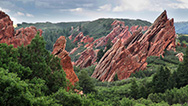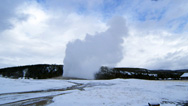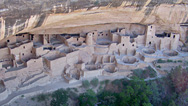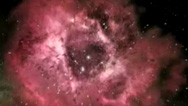Time Travel in the Grand Canyon
- By Arlo Perez
- Posted 08.15.18
- NOVA
Within the Grand Canyon, each stratum of soil is a chapter, and together they form the story of America’s epic geological history. This history stretches hundreds of millions of years into the past, and by rappelling into the Grand Canyon, geologist Kirk Johnson witnesses a sampling of it.
Transcript
Time Travel in the Grand Canyon
Published August 15, 2018
Narrator: This place is a paradise for geologists…and one of our national treasures. It is—of course—the Grand Canyon.
Kirk Johnson: That is a big hole!
Narrator: And it gets me every time.
Johnson: Wow—this is absolutely awesome!
Narrator: The landscape is breathtaking—and so much more.
Johnson: As a geologist the Grand Canyon is perhaps the best place in the world. It’s this incredible 300-mile long slice through the earth…and you can see layer after layer after layer of sedimentary rock.
Narrator: Each layer is a time capsule with a slice of our continent’s epic history locked inside, stretching hundreds of millions of years into the past.
Johnson: Every single one of these layers tells its own story about what North America was like when that layer was deposited. So here in one place you have this incredible story of our continent laid out for your viewing pleasure.
Narrator: But to really tell that story, I’ve got to step out of my comfort zone.
Johnson: So, are you ready for a little time traveling?
Narrator: I’m going to rappel down the cliff to get up close and personal with these rocks.
Johnson: So, it looks like I’m good to step off the edge of the Grand Canyon. I can’t believe I’m doing this. I really don’t like the fact that you've put a cactus right here. This is the moment of truth! Oh baby!
Narrator: This is not the easiest thing to do, especially in a hundred degree heat…but it’s worth it. Every foot I descend transports me further back in time.
Johnson: The first layer you come to in this part of the Canyon is this pinkish rock I’m hanging next to right now. It’s called the Esplanade Layer and like all the rocks in the Grand Canyon, it’s an ancient landscape frozen in time!
Narrator: 300 million years ago, this place—and all of the American Southwest—was a vast sea of sand. Hot, dry winds sculpted an immense desert landscape of endless dunes. Over time the sand compressed and transformed into the sandstone that forms the top ledge of the Grand Canyon here today. Further down, there’s evidence of a very different landscape. About a thousand feet below the rim of the canyon, the rock changes to limestone loaded with fossils.
Johnson: I’ve got a little fossil coral in my hand. And it’s fossils like this that tells us tat this whole landscape was once underwater.
Narrator: 340 million years ago, a warm shallow sea covered all of the American Southwest. Its waters were teeming with trillions of microscopic marine organisms. When they died, their skeletons piled up on the seafloor and compressed into limestone, forming layers that are hundreds of feet thick. And so it goes, layer after layer of rock, telling us the story of long lost landscapes, each one, once the surface of our continent.
Credits
PRODUCTION CREDITS
- Digital Producer
- Arlo Perez
- Editorial Review
- Julia Cort, Ari Daniel
- © WGBH Educational Foundation 2018
MEDIA CREDITS
- Music
- APM
Related Links
-

Making North America: Origins
Experience the colossal geologic forces that shaped our continent over billions of years.
-

The Volcano Under Yellowstone
A giant cauldron of magma simmering beneath Yellowstone is threatening to blow.
-

Making North America: Human
How has the land shaped our lives, from the arrival of the first Americans to today?
-

Origins: Back to the Beginning
Explore the Big Bang, the colossal force that spawned the galaxies, stars, and planets that we see today.

